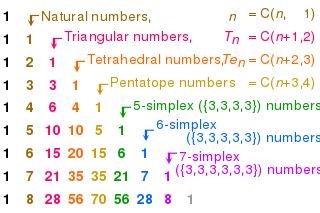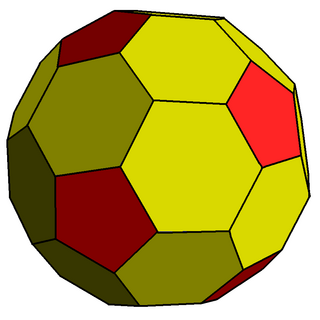Related Research Articles

The term figurate number is used by different writers for members of different sets of numbers, generalizing from triangular numbers to different shapes and different dimensions. The term can mean

In mathematics and combinatorics, a centered hexagonal number, or hex number, is a centered figurate number that represents a hexagon with a dot in the center and all other dots surrounding the center dot in a hexagonal lattice. The following figures illustrate this arrangement for the first four centered hexagonal numbers:
117 is the natural number following 116 and preceding 118.
1729 is the natural number following 1728 and preceding 1730. It is the first nontrivial taxicab number, expressed as the sum of two cubic numbers in two different ways. It is known as the Ramanujan number or Hardy–Ramanujan number after G. H. Hardy and Srinivasa Ramanujan.
In mathematics, an octagonal number is a figurate number that gives the number of points in a certain octagonal arrangement. The octagonal number for n is given by the formula 3n2 − 2n, with n > 0. The first few octagonal numbers are

In mathematics, a pyramid number, or square pyramidal number, is a natural number that counts the stacked spheres in a pyramid with a square base. The study of these numbers goes back to Archimedes and Fibonacci. They are part of a broader topic of figurate numbers representing the numbers of points forming regular patterns within different shapes.
126 is the natural number following 125 and preceding 127.

In number theory, an octahedral number is a figurate number that represents the number of spheres in an octahedron formed from close-packed spheres. The nth octahedral number can be obtained by the formula:
A nonagonal number, or an enneagonal number, is a figurate number that extends the concept of triangular and square numbers to the nonagon. However, unlike the triangular and square numbers, the patterns involved in the construction of nonagonal numbers are not rotationally symmetrical. Specifically, the nth nonagonal number counts the dots in a pattern of n nested nonagons, all sharing a common corner, where the ith nonagon in the pattern has sides made of i dots spaced one unit apart from each other. The nonagonal number for n is given by the formula:

A centered cube number is a centered figurate number that counts the points in a three-dimensional pattern formed by a point surrounded by concentric cubical layers of points, with i2 points on the square faces of the ith layer. Equivalently, it is the number of points in a body-centered cubic pattern within a cube that has n + 1 points along each of its edges.

In number theory, a pentatope number is a number in the fifth cell of any row of Pascal's triangle starting with the 5-term row 1 4 6 4 1, either from left to right or from right to left. It is named because it represents the number of 3-dimensional unit spheres which can be packed into a pentatope of increasing side lengths.

A centered octagonal number is a centered figurate number that represents an octagon with a dot in the center and all other dots surrounding the center dot in successive octagonal layers. The centered octagonal numbers are the same as the odd square numbers. Thus, the nth odd square number and tth centered octagonal number is given by the formula

A centered decagonal number is a centered figurate number that represents a decagon with a dot in the center and all other dots surrounding the center dot in successive decagonal layers. The centered decagonal number for n is given by the formula

The stellated octahedron is the only stellation of the octahedron. It is also called the stella octangula, a name given to it by Johannes Kepler in 1609, though it was known to earlier geometers. It was depicted in Pacioli's De Divina Proportione, 1509.

In geometry, the chamfered dodecahedron is a convex polyhedron with 80 vertices, 120 edges, and 42 faces: 30 hexagons and 12 pentagons. It is constructed as a chamfer (edge-truncation) of a regular dodecahedron. The pentagons are reduced in size and new hexagonal faces are added in place of all the original edges. Its dual is the pentakis icosidodecahedron.
288 is the natural number following 287 and preceding 289. Because 288 = 2 · 12 · 12, it may also be called "two gross" or "two dozen dozen".

Michel Marie Deza was a Soviet and French mathematician, specializing in combinatorics, discrete geometry and graph theory. He was the retired director of research at the French National Centre for Scientific Research (CNRS), the vice president of the European Academy of Sciences, a research professor at the Japan Advanced Institute of Science and Technology, and one of the three founding editors-in-chief of the European Journal of Combinatorics.
In mathematics, a centered tetrahedral number is a centered figurate number that represents a tetrahedron. That is, it counts the dots in a three-dimensional dot pattern with a single dot surrounded by tetrahedral shells. The th centered tetrahedral number, starting at for a single dot, is:

In mathematics, a centered octahedral number or Haüy octahedral number is a figurate number that counts the points of a three-dimensional integer lattice that lie inside an octahedron centered at the origin. The same numbers are special cases of the Delannoy numbers, which count certain two-dimensional lattice paths. The Haüy octahedral numbers are named after René Just Haüy.
Elena Ivanovna Deza is a French and Russian mathematician known for her books on metric spaces and figurate numbers.
References
- Deza, Elena; Deza, Michel (2012). Figurate Numbers. Singapore: World Scientific Publishing. p. 120. ISBN 978-981-4355-48-3.